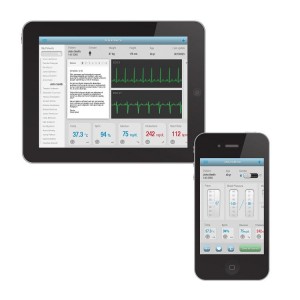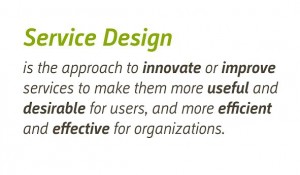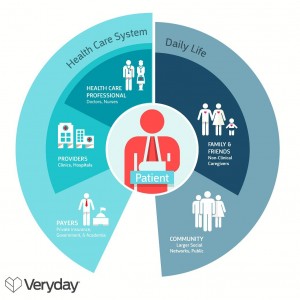“Connected Health is the coming together of technology, devices, and people to enable increased access, improved care, lower costs and better outcomes.”
– Montana Cherney, Connected Health – The User-Driven Transformation of Healthcare, Stockholm & New York, 2013.
Health and well being are key human needs and the foundation for individuals and societies to prosper. Life Science players and health care providers seek to continuously improve how they support a better life for patients, health care professionals (HCPs) and other stakeholders. The challenge lies in these efforts being largely isolated from one other. To meet the needs of all involved, it’s imperative to understand the full picture and to think in user-driven health care ecosystems. The question is, how can we get started?
The new landscape – Connected Health
While at the TEDMED conference in Washington DC in April 2013, we were excited to experience the debut of the Smartphone Physical – touted as providing “a unique glimpse into the future of the exam room.” A conference-style booth was set up wherein attendees could sign up to visit any or all of the stations where these new technologies were on display. Being one of the most popular exhibits, many of us stood in line for up to 30 minutes to have our visual acuity measured with the EyeNetra NETRA-G, have our blood pressure and heart rate measured with the Withings Blood Pressure Monitor and experience a carotid artery visualization with the Mobisante probe. The technology was, of course, fascinating, but the overall experience fell flat because the organizers had put the technology – not the user – first. Had they focused on choreographing the service experience – or the annual well visit from start to finish – visitors would likely have been able to feel the true impact these new technologies may have on our care experiences.
 Ubiquitous connectivity and mobility have changed the way we live and many sectors, as a result, have been reimagined – from transportation and entertainment to education and banking. The companies and industries that have reaped the most reward have been those that have taken a user-centred approach to their evolution, first understanding the core needs of their users to better design services for them. Health care is feeling the need to reinvent itself as stakeholders are adapting to the digital transformation of the entire industry. To reach the next level we need to connect the dots and think in sustainable and user-centered connected services rather than discrete, technology-focused solutions. The Service Design approach is an effective way to develop this more holistic view – to map out the entire ecosystem and gain deep insights about present and future needs of the different stakeholders.
Ubiquitous connectivity and mobility have changed the way we live and many sectors, as a result, have been reimagined – from transportation and entertainment to education and banking. The companies and industries that have reaped the most reward have been those that have taken a user-centred approach to their evolution, first understanding the core needs of their users to better design services for them. Health care is feeling the need to reinvent itself as stakeholders are adapting to the digital transformation of the entire industry. To reach the next level we need to connect the dots and think in sustainable and user-centered connected services rather than discrete, technology-focused solutions. The Service Design approach is an effective way to develop this more holistic view – to map out the entire ecosystem and gain deep insights about present and future needs of the different stakeholders.
The implications – changing roles and rules
 In this new landscape the different actors in the system are more connected as individuals. But what does that mean? With constant access to information (health information sites and online health and wellness communities) and a plethora of tools (devices and apps) for collecting biometric data, patients are becoming the experts on themselves and their conditions so they can better advocate for what care they need and how and when they want that care to be delivered. With social health networks on the rise, family, friends and communities are becoming more empowered members of care teams. With secure cloud-based tools and the growth of mobile devices in the workplace, HCP’s are able to provide better care while increasing efficiency. And with big data, industry players are able to tap into what’s working for their customers as a means to more often deliver what those customers really need and want.
In this new landscape the different actors in the system are more connected as individuals. But what does that mean? With constant access to information (health information sites and online health and wellness communities) and a plethora of tools (devices and apps) for collecting biometric data, patients are becoming the experts on themselves and their conditions so they can better advocate for what care they need and how and when they want that care to be delivered. With social health networks on the rise, family, friends and communities are becoming more empowered members of care teams. With secure cloud-based tools and the growth of mobile devices in the workplace, HCP’s are able to provide better care while increasing efficiency. And with big data, industry players are able to tap into what’s working for their customers as a means to more often deliver what those customers really need and want.
 The problem is, in order to work more efficiently, the entire ecosystem needs to be connected so that each actor’s preferred outcome may be realized. A lot of potential and opportunities open up. But who is driving this and who is connecting all these dots in the ecosystem? What are the methods and ways of thinking that help speed up and improve this transformation? One starting point is to understand the issues from the perspective of the key players in the ecosystem – what aims do they have, what can they gain from the new landscape and what are the most desirable future outcomes?
The problem is, in order to work more efficiently, the entire ecosystem needs to be connected so that each actor’s preferred outcome may be realized. A lot of potential and opportunities open up. But who is driving this and who is connecting all these dots in the ecosystem? What are the methods and ways of thinking that help speed up and improve this transformation? One starting point is to understand the issues from the perspective of the key players in the ecosystem – what aims do they have, what can they gain from the new landscape and what are the most desirable future outcomes?
The transformation from different perspectives
Individuals – in good health or as patients – seek to lead healthy lives. They want faster and more convenient services, better outcomes and lower costs. Family and friends seek better tools to more actively support their loved ones; and communities want access to data and networks of people to better support their health.
Healthcare professionals want more efficient tools so they can spend more time caring for patients; providers are looking for greater efficiency and reduced costs; payers wish to increase value for their money by improving outcomes; and industry players seek to continuously develop safe, cost-effective and differentiated products that meet their customers’ needs and touch their customers in more and more areas of their lives. Society will prosper when general wellbeing is improved. However reducing costs and population risk are critical, too.
Pinpointing challenges and barriers
In systems, the goals of one user group can run counter to another’s, slowing the potential for transformation. HCP’s, providers, payers and industry players are hampering progress by providing piecemeal, fragmented and what is considered by patients as far too expensive care because they are beholden to an overly complex system that is resistant and slow to change. Governments are enforcing extremely slow and highly fragmented regulations that are not keeping pace with technical innovation or with consumer expectations. Providers are not putting the right IT in place to support their staff; and many HCP’s simply don’t have the current tools they need to perform their jobs to the best of their ability. And finally, many industry players need help in enhancing their understanding and in-depth consideration of HCP’s¹ workflow and social obstacles.
So the question becomes, how do we start connecting the dots between the users in the ecosystem to provide better care and improve health? First, we need to ‘identify the dots’ and define ‘how the dots behave.’ We need to start by looking towards the future and understanding what health care will look like tomorrow.
The key ‘transformers’ of health care are:
- Democratized Care – People will have access to care and data, regardless of location, condition or socio-economic status.
- Personalized Care – A holistic picture of a patient will be available such that those providing care can deliver individualized treatments.
- Collaborative Care – Patients, their caregivers and the community will become more active and empowered members of the care team.
- Anytime, Anywhere Care – Care that happens anytime and anywhere will enable a shift from discrete moments of care to a seamless care continuum.
By laying these four aspects as the foundation, a new care paradigm will be possible. It will be proactive, allowing care to happen when a person is in need, regardless of time or location; preventative, in which lifestyle changes become an essential part of treatment plans; predictive, so that acute incidents and pandemics can get the swift response they need; and preemptive, so that we can stop disease before it starts. And this new care paradigm will enable a whole host of benefits for users such as greater accessibility, independence, flexibility, effectiveness, efficiency, transparency, interoperability, intelligence and integration, to name but a few.
The transformation of healthcare is already underway and there are several successful connected health solutions that serve as powerful demonstrations and inspiration. You may view just a few here: http://pinterest.com/montanaquinn/connected-health/.
Designing for a total user experience
What are the tools and ways of working that allow for this transformation to move faster and to become more effective? Service Design has been emerging over the last 15 years as an approach to innovate or improve services to make them more useful, usable and desirable for customers, and more efficient and effective for organizations. A Service Design approach facilitates a more effective collaboration between stakeholders as well as inviting users to participate in the design process. Design can help with the thoughtful and imaginative improvement of processes, services and interactions in complex service delivery chains. A user’s experiences cannot really be designed but the systems, organizations, roles and tools enabling those experiences can.
What’s next?
This transformation is not a revolution that will be owned and driven by one player or leader. The ecosystem needs to evolve and develop collaboratively and cooperatively for the vision of Connected Health to become reality. What is needed is that everybody does their part – not just those within the formal health care system, but the industry players who are creating solutions to keep the system going. It will be a joint effort but if we get moving together, we will lead better and happier lives in prospering societies.
So what are the questions you should ask yourself, your colleagues, your customers and your networks to be at the forefront of the Connected Health transformation?
- What are our customers’ unmet needs?
- How will the changing expectations of our stakeholders influence our industry?
- Are we meeting our stakeholders’ needs and expectations?
- What will be our role in the transformation of health care?
- Who, internally, could be a good source to leverage knowledge and best practices?
- What are our competitors doing to adapt to the connected Health transformation?
- What can we learn from our competitors?
- What can we learn from other industries?
- Can we be more transparent with our organization’s needs and challenges as a means to solve them more efficiently and effectively?
- What will happen if we do not act now?






